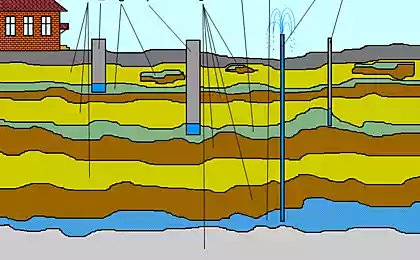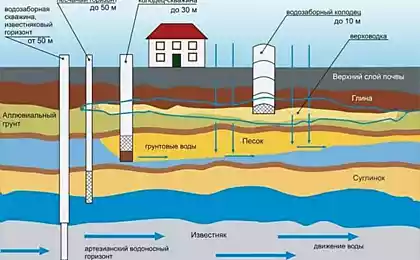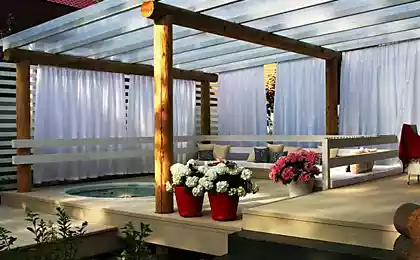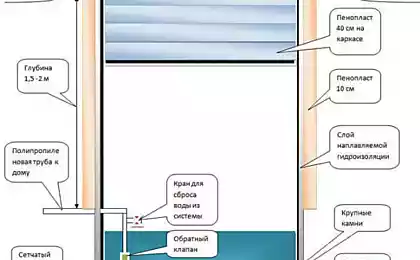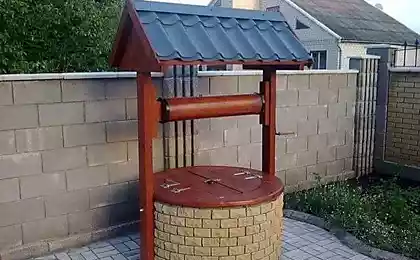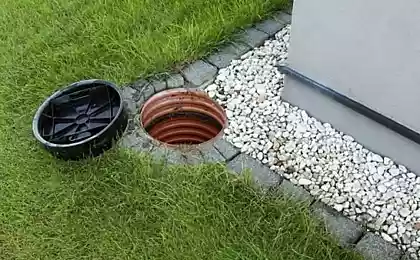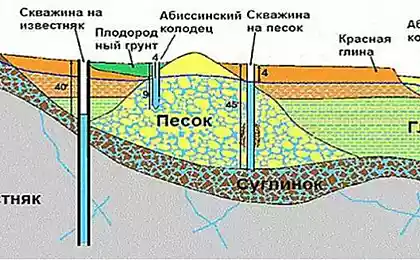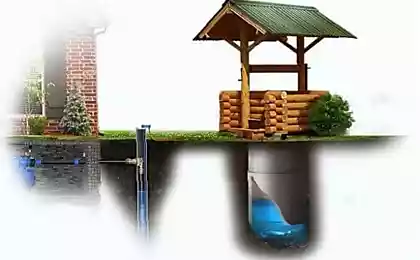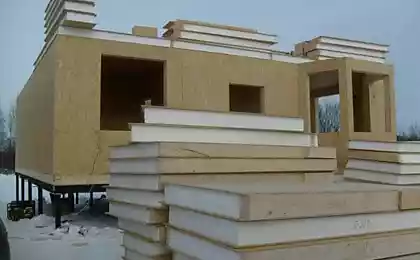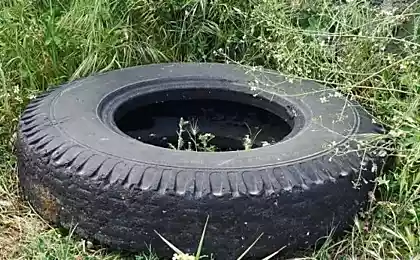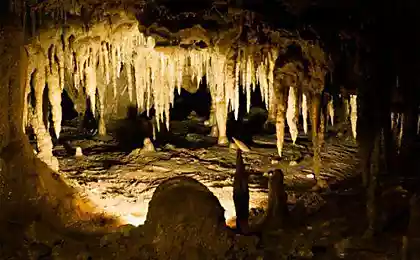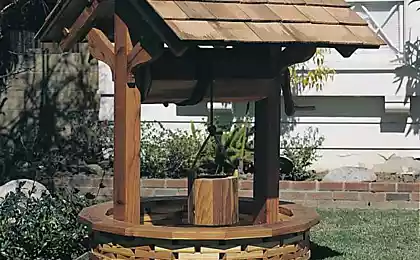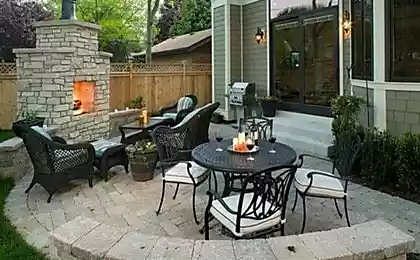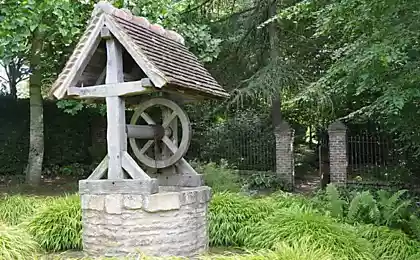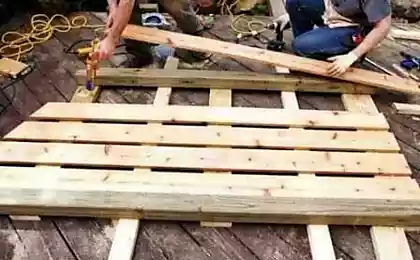703
Water at the dacha with his hands
More recently, a private home was associated with a number of inconveniences. For example, a bath or shower in the house was not full and the kitchen sink too, the toilet is outside, wash only by hand. The water had to carry buckets from the nearest well or gain from the well with a crane located on the street.
In the end, everyone brought something and spend. Wash the dishes in the bowl, bathe in a basin after heating water in a large bowl. All these problems are solved by a fully private home water and proper sanitation. Even on the basis of already existing well or wells can be implemented summing up the water directly into the house for all consumers. This will allow you to enjoy all the benefits of modern civilization, such as washing machine, dishwasher, you can take a shower or other water in the house.
What might be the supply of private homes
There are several ways the arrangement of the water supply in a private house, different sources of water intake.
Centralized water supply is only possible if near a waterway. For connection it is necessary to contact the organization for controlling the water systems in Your area. The organization will provide the technical specifications of connecting a house to the supply pipeline. There will indicate the place of connection, the depth of the water pipes, their diameter, and water pressure (pressure), which is guaranteed.
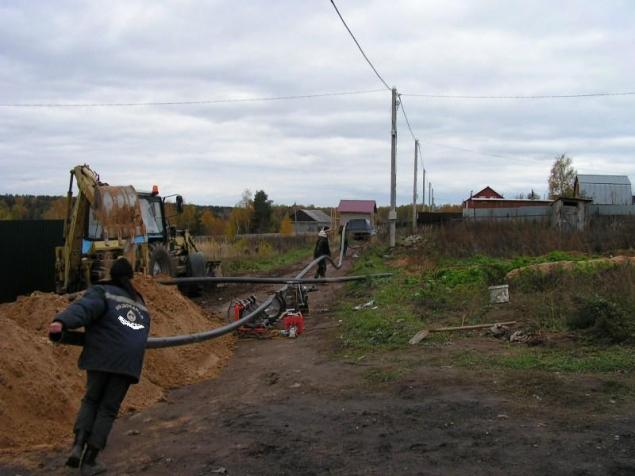
In practice, the connection of a private house with Central water supply has a number of disadvantages: the water pressure might drop, or be very small, insufficient for the normal functioning of water supply, water contains chlorine and other additives. Also in case of an accident on the line, the house will be without water. But if the power goes out, the water flow will not stop. For the services of a Central water supply system need to pay monthly according to metered water consumption.
Autonomous water supply of a private house can be implemented using the abstraction of water from a well or borehole.
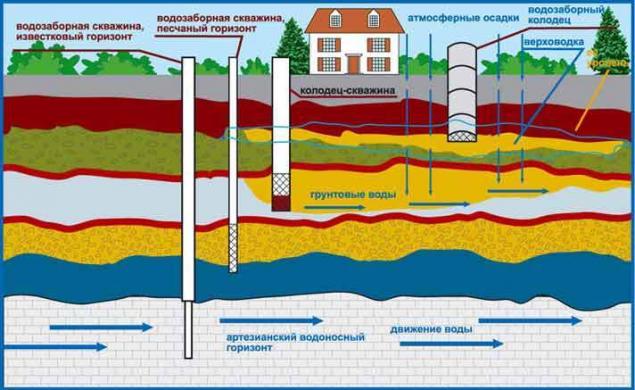
It is better to build on the land, a well or a borehole depends on the soil properties, the depth and location of aquifers, as well as the performance of the water veins.
Well basically equip when of a quality suitable for human consumption water is located at the level from 4 to 15 m deep. In this aquifer should be large enough to provide all the needs of a family of 4 persons. Average water capacity – 200 l. For the reason that the well may penetrate the groundwater, water quality may be low.
The undeniable advantage of a well is that in the event of a power cut water can collect in the usual bucket on a rope. Also the life of the well is at least 50 years, which is significantly more than wells. The cost of resettlement of the well less well. If you dig the mine well manually by yourself, you will have to pay only for the material for the walls and for the work on their installation.
Before you make a decision on what to do on the site, a well or borehole, meet the locals, take their water samples for analysis. Most often if in the area, all dig wells, it makes sense to take advantage of their experience and not to reinvent the wheel. Just as is the case with wells.
Depending on the depth and variety of the layer from which water is taken, there are well "in the sand" and artesian wells.
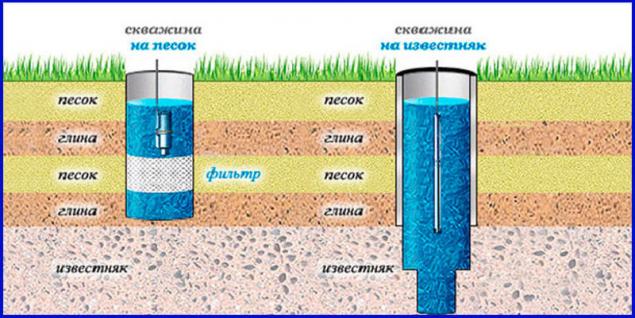
Well "on the sand" got its name from the fact that affects the upper aquifers of the so-called sandy horizon that goes behind a thick layer of silt, filter groundwater. The depth of this well can reach 40 – 50 m. In different regions occurrence of this aquifer may be different. There are cases that when drilling a borehole it is possible to get to the underground river channel at a depth of 15 m. In this case, pipes and filters will not be clogged with sand since the layer structure consists of pebbles. The service life of such wells can reach 15 – 20 years, whereas conventional wells "the sand" will last 5 – 7 years. The supply of water of about 500 l. to Drill such wells can be manually, it is much cheaper, and the excavation will be smaller. More likely to get a good aquifer because drilling is happening empirically. Machine drilling is much more expensive, but less effective, since the machine has a borehole to a predetermined depth, to get to a good aquifer in this case is quite difficult.
Artesian well goes down to the aquifer in the limestone rocks. Depth can reach 135 m. of Course, this water is much better water top layers. The supply is practically unlimited, minimum 1500 L. Special equipment for water intake is not necessary, since the water is under pressure, she fires up. The probability of waste or groundwater in an artesian well is completely eliminated. The lifetime is the same as at the well – up to 50 years. The cost of drilling is much higher than that of the wells "in the sand" for greater depth. And, most importantly, artesian wells, it is necessary to register as a limestone aquifer relates to the strategic reserve of the state.
The scheme of water supply of a private house involves the use for the water intake of the pump or pumping station. They are installed in the house in a utility room, or directly over the bore in the casing and connected to the water source pipe. The pump pumps water into the pressure tank. From him around the house to a split pipe to the consumers. When someone in the house begins to consume water, for example, turned on the faucet in the shower or in the kitchen, the pressure in the system gradually decreases. When it reaches 2.2 bar, relay and pressure switch on the pump, which pumps water into the pressure tank, until the pressure becomes 3 bar. Again triggered the pressure switch and the pump stops.
Diagram of water supply system in private house
In brief the scheme of water supply of the house consists of the following elements:
Water source: well, bore or river. Pump for water intake from the source. The pressure that is needed to create some pressure in the system. With the help of it you can control on and off of the pump. Filters for water treatment. To correctly select the equipment, it is necessary to take water samples and do tests. Technical water to be used for washing car, watering the garden or other needs, there is no need to filter. Therefore, it is given a separate tube, bypassing the treatment system. Installation water-heating equipment for hot water supply. Collector pipe system with hot and cold water. To arrange private home water your hand is best in warm seasons, when the water level is low, and the chance to make a mistake with the location of the aquifer is very small and the soil is pliable, easy to dig trenches. Depending on the conditions of water intake, where is the water source, how deep, what type, use different pumps. The accumulator is also quite an expensive unit. So many its not installed, and used other methods of pump control are made independently.
Private home water from the well
Despite the universal fashion for the well, yet in many regions prefer to dig wells to provide themselves with water. Largely the reason is that in the case of force majeure, it is possible to draw water in the usual bucket.
Taking water samples from neighboring wells for analysis and getting satisfactory results, you can begin to search for your well.
Look for the best place to well where there is abundant aquifers lived on a not very great depth, by using antiquated methods, or modern appliances. Still failsafe is monitoring the presence and amount of dew very early in the morning (4 – 5am in the summer) within six months. The information collected conspicious, and then prepared diagrams and defines the place where the most water.
You also need to consider a number of sanitary restrictions: at a distance of 50 m must not be toilets, cesspools, sewage, compost heaps or other sources of contamination. It is also important to locate a well too close to home, as the leaching of sand from the floaters may lead to shifts in the Foundation.
After finding the place, you can order a water supply project of a private house. In principle it can be done independently, with minimal engineering skills, but it is better not to risk it. While preparing the project, you can begin to dig a well.
How to dig a holewe Will consider a variant of the well with reinforced concrete rings. First level the area where you are going to do well. Then draw a circle with a radius of 10 – 20 cm larger than the radius of the ring.
With a spade dig a round hole of the required diameter. Stop when the concrete ring in the hole will be 10 cm. most Often, the height of the ring is 90 cm, but sometimes 100 cm.
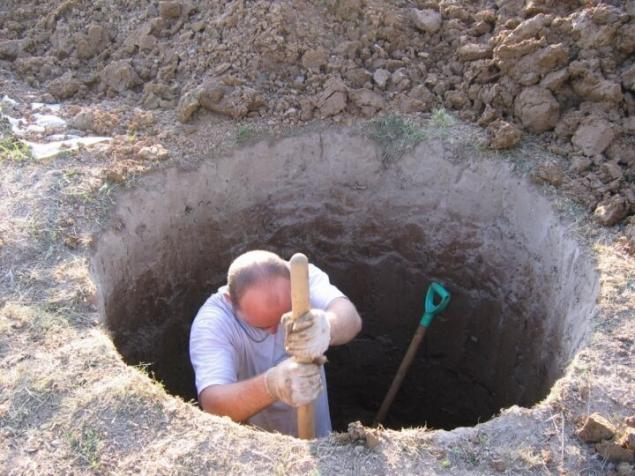
Installed the first concrete ring. To do this, carefully deliver the ring to the hole in a sideways position, then turn over and drop into the pit. On the end installed a minimum of 3 joining bracket.
Then continue to dig, again to a depth of one ring. The soil is put into a container and lifted up. Drop the first ring down and install the second bracket. As we plan to have the plumbing in the house in the second ring to make a hole for the pipe with diameter 1.5 times the diameter of the pipe.
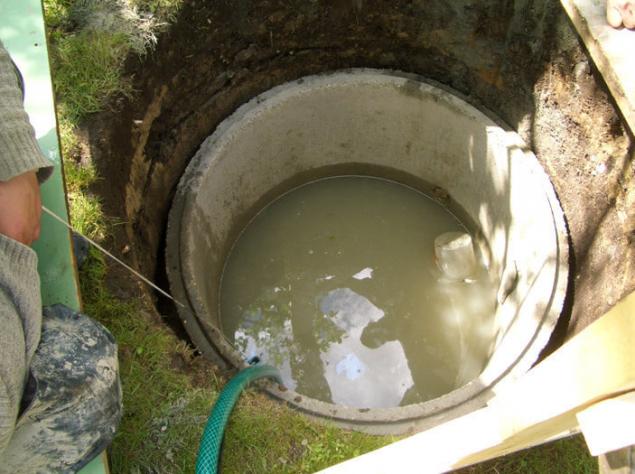
Continue to dig and install new rings while in the well will rapidly arriving water. Roughly it should occur after 6 to 8 rings. It is advisable to aquifers lived (Fontanelle) was more like 3. Stop and start to pump out water and sand, which is washed. Continue to deepen into the ground for another 40 – 50 cm, while the pump pumps, as the water stays quite intense.
When the excavation is completed, leaving the mine pit for a day filled with water, we need to know its level. Close future well anything so that no one accidentally fell inside. Through the day look, how to water well. If more than 1 – 1.5 m – good. Again, pumped all the water.
At the bottom laid small stones on top of gravel layer 30 – 50 cm This will be our filter.
Sealed all the cracks between the rings cement-sand mortar to perched not fall into the pit. If we did everything correctly, the well shall be filled to about 1.5 concrete ring.
How to connect the pumping station to the well
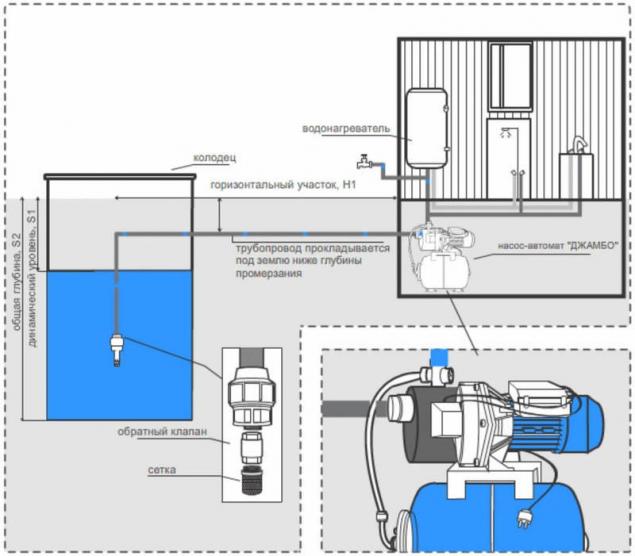
Place the water in a private house involves lifting water from a well with pumping station and distribution around the house.
Pump or pumping station for a well best place in the house or the utility room. Therefore, from the well to the house dig a trench below the freezing depth of soil and put it in the pipe.
The material of the pipes is different – steel, plastic, copper and others. Choose according to the budget and of the required characteristics. The convenience of plastic pipes is that they can bend. Set up the pipe in the hole in the ring of the well, bend it and drop down to the water. Inside insert mesh inlet filter.
The pipe should reach the bottom of the well at 30 – 40 cm Now, again, pumped all the water from a well, driven into the bottom of the pin and attach it to the pipe. A hole in a concrete ring for pipe sealed with cement mortar.
Filling in the trench and arrange the clay lock around the well at a depth of 40 cm, thickness 50 cm, at a distance of not less than 1.5 m from the rings. This is necessary to protect a well from contact with rainwater and groundwater.
For the correct selection of pump station need to know the characteristics of our well. The most common pumps pump water from depths of 9 m and up to 40 m. But for a structure on the deletion makes sense to purchase self priming centrifugal pump with external ejector, which can lift water from depths up to 45 m.
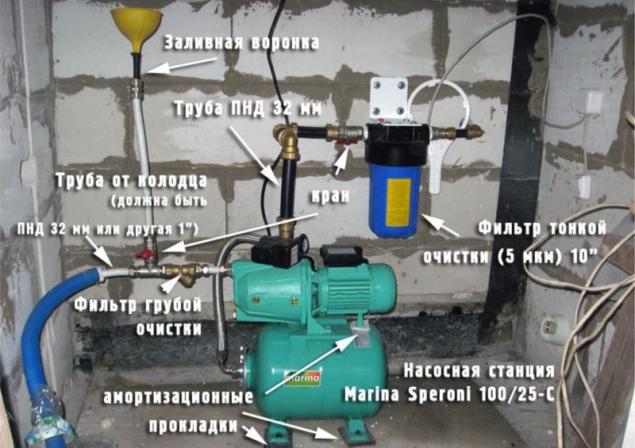
Indoors, where there will be a pumping station, winter temperature should not fall below +2 °C. the coarse Filter and check valve installed before the inlet of the pump. The fine filter is put after the pumping station. Connect pressure switches, pressure gauge and other devices. Attach the pipe to the manifold distributes it to consumers. A pumping station connected to the dashboard.
Will just have to mount the water – and you're done.
Private home water from the wellthe Main advantage of the wells are more clean and high quality water with smaller portions of the perched, a larger supply of water for domestic needs of a large family.
On the location of wells subject to the same restrictions on the well. Except for the fact that it is possible to drill close to home.
The price of the well water depends on the type of well, method of drilling, so it is individual for everyone.
How to drill a wellTo drill wells manually use a tripod, the drill column with the drill and lift.
Over the future of the well established tripod and starts drilling and dredging.
For the first 1 – 1.5 m pin drill is used to remove the soil from the top. Then is inserted into the hole casing tube with the teeth and the drilling continues until, until you find a suitable aquifer. The first layers can be skipped and drill further. When a layer is found inside of the casing is inserted galvanized water pipe with a filter on the end. Sections of pipe connected by couplings, the connection is coated with sealant carefully. Then the casing pipe is removed.
For the well pit must be equipped with at least 1 m deep. It 10 – 15 cm from the bottom "Peeps" pipe bore.
How to connect a pumping station wellpumping station in two ways. The first is directly over the bore to equip a small warm room if it is close to home. Second – over the well to install a caisson, which will be the pump.
In the first method we will not dwell, since it is more or less simple. Consider the installation of a caisson.
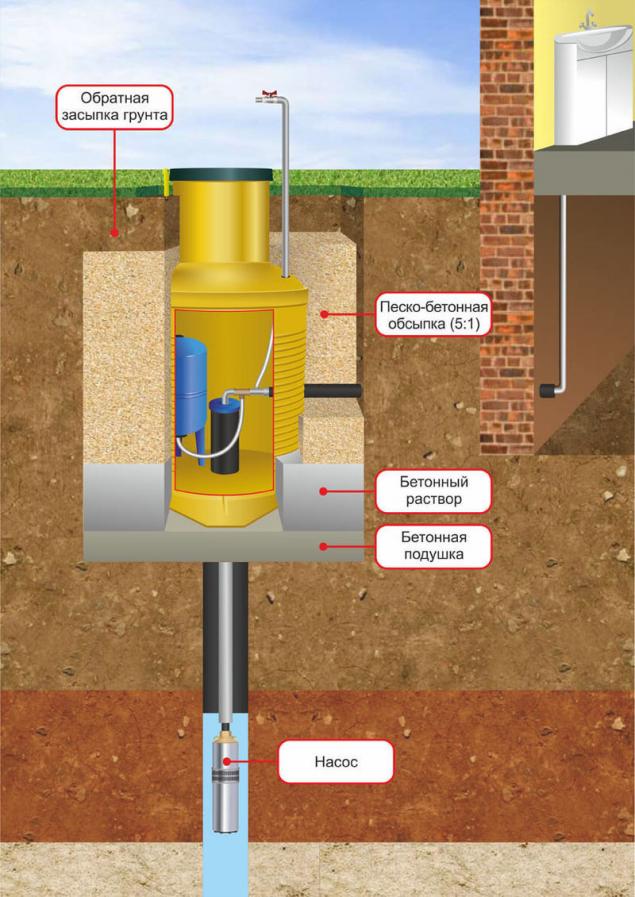
Obketive pipe to a depth of 2.5 m, diameter 2 times as large as the diameter of the caisson. On the bottom pour the slab 20 cm thick, which will keep the weight of the caisson itself.
Then install the caisson into the pit. Pipe well clipped so that it is performed at 500 mm inside the caisson. At this level, at a depth of about 1,8 – 2 m digging a trench that leads to the house. It laid a water pipe.
Pump installed in a caisson and connected to the tube wells. But the pressure that the pump will pump the water, you still need to install somewhere in the house or the utility room. There are installed filters, and the control unit of the pump station.
The caisson on the contour of the fill concrete layer 30 – 40 cm When the concrete is dry, the rest of the space, not reaching 50 cm to the top, filled with a mixture of sand and cement. The top is filled with soil. The caisson will be well protected from frost.
Hot water private home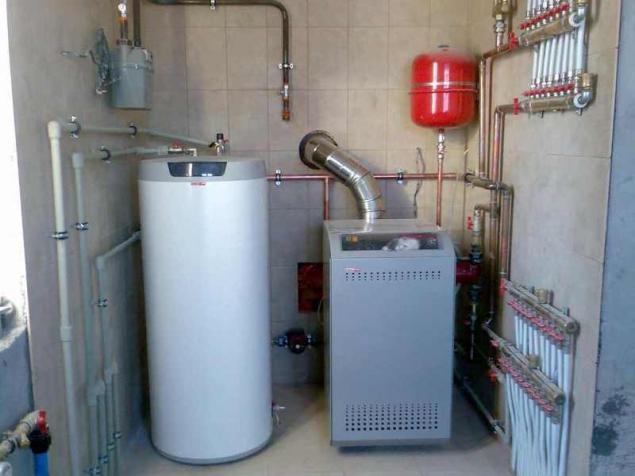
When water is supplied directly into the house, heating it will not be easy. You can use several options.
The first – set double-boiler, e.g. gas. One circuit will heat water for the heating system, the second – for household needs. From the pumping station the cold water pipe connects to the boiler, comes from a pipe with hot water and is connected to the manifold which distributes water throughout the house.
The second option – install single-circuit boiler, which will deal purely with water heating requirements of a home. It can be gas or electric. To it it is necessary to establish the boiler.
The third option – installed electric water heater.
The fourth is suitable for large houses. You can install many flow nagrevaemoi every consumer.
Installation of water supply in a private home will be complete when around the house will be mounted plumbing with hot and cold water. You should also take care of discharge, i.e. sewer or septic tank. Water disposal is a required element. Now to make water buckets will not work. It is necessary to arrange drainage of water from the sink, shower, bathtub, washing machine and toilet. published
P. S. And remember, only by changing their consumption — together we change the world! ©
Source: strport.ru/stroitelstvo-domov/vodosnabzhenie-chastnogo-doma-svoimi-rukami
In the end, everyone brought something and spend. Wash the dishes in the bowl, bathe in a basin after heating water in a large bowl. All these problems are solved by a fully private home water and proper sanitation. Even on the basis of already existing well or wells can be implemented summing up the water directly into the house for all consumers. This will allow you to enjoy all the benefits of modern civilization, such as washing machine, dishwasher, you can take a shower or other water in the house.
What might be the supply of private homes
There are several ways the arrangement of the water supply in a private house, different sources of water intake.
Centralized water supply is only possible if near a waterway. For connection it is necessary to contact the organization for controlling the water systems in Your area. The organization will provide the technical specifications of connecting a house to the supply pipeline. There will indicate the place of connection, the depth of the water pipes, their diameter, and water pressure (pressure), which is guaranteed.

In practice, the connection of a private house with Central water supply has a number of disadvantages: the water pressure might drop, or be very small, insufficient for the normal functioning of water supply, water contains chlorine and other additives. Also in case of an accident on the line, the house will be without water. But if the power goes out, the water flow will not stop. For the services of a Central water supply system need to pay monthly according to metered water consumption.
Autonomous water supply of a private house can be implemented using the abstraction of water from a well or borehole.

It is better to build on the land, a well or a borehole depends on the soil properties, the depth and location of aquifers, as well as the performance of the water veins.
Well basically equip when of a quality suitable for human consumption water is located at the level from 4 to 15 m deep. In this aquifer should be large enough to provide all the needs of a family of 4 persons. Average water capacity – 200 l. For the reason that the well may penetrate the groundwater, water quality may be low.
The undeniable advantage of a well is that in the event of a power cut water can collect in the usual bucket on a rope. Also the life of the well is at least 50 years, which is significantly more than wells. The cost of resettlement of the well less well. If you dig the mine well manually by yourself, you will have to pay only for the material for the walls and for the work on their installation.
Before you make a decision on what to do on the site, a well or borehole, meet the locals, take their water samples for analysis. Most often if in the area, all dig wells, it makes sense to take advantage of their experience and not to reinvent the wheel. Just as is the case with wells.
Depending on the depth and variety of the layer from which water is taken, there are well "in the sand" and artesian wells.

Well "on the sand" got its name from the fact that affects the upper aquifers of the so-called sandy horizon that goes behind a thick layer of silt, filter groundwater. The depth of this well can reach 40 – 50 m. In different regions occurrence of this aquifer may be different. There are cases that when drilling a borehole it is possible to get to the underground river channel at a depth of 15 m. In this case, pipes and filters will not be clogged with sand since the layer structure consists of pebbles. The service life of such wells can reach 15 – 20 years, whereas conventional wells "the sand" will last 5 – 7 years. The supply of water of about 500 l. to Drill such wells can be manually, it is much cheaper, and the excavation will be smaller. More likely to get a good aquifer because drilling is happening empirically. Machine drilling is much more expensive, but less effective, since the machine has a borehole to a predetermined depth, to get to a good aquifer in this case is quite difficult.
Artesian well goes down to the aquifer in the limestone rocks. Depth can reach 135 m. of Course, this water is much better water top layers. The supply is practically unlimited, minimum 1500 L. Special equipment for water intake is not necessary, since the water is under pressure, she fires up. The probability of waste or groundwater in an artesian well is completely eliminated. The lifetime is the same as at the well – up to 50 years. The cost of drilling is much higher than that of the wells "in the sand" for greater depth. And, most importantly, artesian wells, it is necessary to register as a limestone aquifer relates to the strategic reserve of the state.
The scheme of water supply of a private house involves the use for the water intake of the pump or pumping station. They are installed in the house in a utility room, or directly over the bore in the casing and connected to the water source pipe. The pump pumps water into the pressure tank. From him around the house to a split pipe to the consumers. When someone in the house begins to consume water, for example, turned on the faucet in the shower or in the kitchen, the pressure in the system gradually decreases. When it reaches 2.2 bar, relay and pressure switch on the pump, which pumps water into the pressure tank, until the pressure becomes 3 bar. Again triggered the pressure switch and the pump stops.
Diagram of water supply system in private house
In brief the scheme of water supply of the house consists of the following elements:
Water source: well, bore or river. Pump for water intake from the source. The pressure that is needed to create some pressure in the system. With the help of it you can control on and off of the pump. Filters for water treatment. To correctly select the equipment, it is necessary to take water samples and do tests. Technical water to be used for washing car, watering the garden or other needs, there is no need to filter. Therefore, it is given a separate tube, bypassing the treatment system. Installation water-heating equipment for hot water supply. Collector pipe system with hot and cold water. To arrange private home water your hand is best in warm seasons, when the water level is low, and the chance to make a mistake with the location of the aquifer is very small and the soil is pliable, easy to dig trenches. Depending on the conditions of water intake, where is the water source, how deep, what type, use different pumps. The accumulator is also quite an expensive unit. So many its not installed, and used other methods of pump control are made independently.
Private home water from the well
Despite the universal fashion for the well, yet in many regions prefer to dig wells to provide themselves with water. Largely the reason is that in the case of force majeure, it is possible to draw water in the usual bucket.
Taking water samples from neighboring wells for analysis and getting satisfactory results, you can begin to search for your well.
Look for the best place to well where there is abundant aquifers lived on a not very great depth, by using antiquated methods, or modern appliances. Still failsafe is monitoring the presence and amount of dew very early in the morning (4 – 5am in the summer) within six months. The information collected conspicious, and then prepared diagrams and defines the place where the most water.
You also need to consider a number of sanitary restrictions: at a distance of 50 m must not be toilets, cesspools, sewage, compost heaps or other sources of contamination. It is also important to locate a well too close to home, as the leaching of sand from the floaters may lead to shifts in the Foundation.
After finding the place, you can order a water supply project of a private house. In principle it can be done independently, with minimal engineering skills, but it is better not to risk it. While preparing the project, you can begin to dig a well.
How to dig a holewe Will consider a variant of the well with reinforced concrete rings. First level the area where you are going to do well. Then draw a circle with a radius of 10 – 20 cm larger than the radius of the ring.
With a spade dig a round hole of the required diameter. Stop when the concrete ring in the hole will be 10 cm. most Often, the height of the ring is 90 cm, but sometimes 100 cm.

Installed the first concrete ring. To do this, carefully deliver the ring to the hole in a sideways position, then turn over and drop into the pit. On the end installed a minimum of 3 joining bracket.
Then continue to dig, again to a depth of one ring. The soil is put into a container and lifted up. Drop the first ring down and install the second bracket. As we plan to have the plumbing in the house in the second ring to make a hole for the pipe with diameter 1.5 times the diameter of the pipe.

Continue to dig and install new rings while in the well will rapidly arriving water. Roughly it should occur after 6 to 8 rings. It is advisable to aquifers lived (Fontanelle) was more like 3. Stop and start to pump out water and sand, which is washed. Continue to deepen into the ground for another 40 – 50 cm, while the pump pumps, as the water stays quite intense.
When the excavation is completed, leaving the mine pit for a day filled with water, we need to know its level. Close future well anything so that no one accidentally fell inside. Through the day look, how to water well. If more than 1 – 1.5 m – good. Again, pumped all the water.
At the bottom laid small stones on top of gravel layer 30 – 50 cm This will be our filter.
Sealed all the cracks between the rings cement-sand mortar to perched not fall into the pit. If we did everything correctly, the well shall be filled to about 1.5 concrete ring.
How to connect the pumping station to the well

Place the water in a private house involves lifting water from a well with pumping station and distribution around the house.
Pump or pumping station for a well best place in the house or the utility room. Therefore, from the well to the house dig a trench below the freezing depth of soil and put it in the pipe.
The material of the pipes is different – steel, plastic, copper and others. Choose according to the budget and of the required characteristics. The convenience of plastic pipes is that they can bend. Set up the pipe in the hole in the ring of the well, bend it and drop down to the water. Inside insert mesh inlet filter.
The pipe should reach the bottom of the well at 30 – 40 cm Now, again, pumped all the water from a well, driven into the bottom of the pin and attach it to the pipe. A hole in a concrete ring for pipe sealed with cement mortar.
Filling in the trench and arrange the clay lock around the well at a depth of 40 cm, thickness 50 cm, at a distance of not less than 1.5 m from the rings. This is necessary to protect a well from contact with rainwater and groundwater.
For the correct selection of pump station need to know the characteristics of our well. The most common pumps pump water from depths of 9 m and up to 40 m. But for a structure on the deletion makes sense to purchase self priming centrifugal pump with external ejector, which can lift water from depths up to 45 m.

Indoors, where there will be a pumping station, winter temperature should not fall below +2 °C. the coarse Filter and check valve installed before the inlet of the pump. The fine filter is put after the pumping station. Connect pressure switches, pressure gauge and other devices. Attach the pipe to the manifold distributes it to consumers. A pumping station connected to the dashboard.
Will just have to mount the water – and you're done.
Private home water from the wellthe Main advantage of the wells are more clean and high quality water with smaller portions of the perched, a larger supply of water for domestic needs of a large family.
On the location of wells subject to the same restrictions on the well. Except for the fact that it is possible to drill close to home.
The price of the well water depends on the type of well, method of drilling, so it is individual for everyone.
How to drill a wellTo drill wells manually use a tripod, the drill column with the drill and lift.
Over the future of the well established tripod and starts drilling and dredging.
For the first 1 – 1.5 m pin drill is used to remove the soil from the top. Then is inserted into the hole casing tube with the teeth and the drilling continues until, until you find a suitable aquifer. The first layers can be skipped and drill further. When a layer is found inside of the casing is inserted galvanized water pipe with a filter on the end. Sections of pipe connected by couplings, the connection is coated with sealant carefully. Then the casing pipe is removed.
For the well pit must be equipped with at least 1 m deep. It 10 – 15 cm from the bottom "Peeps" pipe bore.
How to connect a pumping station wellpumping station in two ways. The first is directly over the bore to equip a small warm room if it is close to home. Second – over the well to install a caisson, which will be the pump.
In the first method we will not dwell, since it is more or less simple. Consider the installation of a caisson.

Obketive pipe to a depth of 2.5 m, diameter 2 times as large as the diameter of the caisson. On the bottom pour the slab 20 cm thick, which will keep the weight of the caisson itself.
Then install the caisson into the pit. Pipe well clipped so that it is performed at 500 mm inside the caisson. At this level, at a depth of about 1,8 – 2 m digging a trench that leads to the house. It laid a water pipe.
Pump installed in a caisson and connected to the tube wells. But the pressure that the pump will pump the water, you still need to install somewhere in the house or the utility room. There are installed filters, and the control unit of the pump station.
The caisson on the contour of the fill concrete layer 30 – 40 cm When the concrete is dry, the rest of the space, not reaching 50 cm to the top, filled with a mixture of sand and cement. The top is filled with soil. The caisson will be well protected from frost.
Hot water private home

When water is supplied directly into the house, heating it will not be easy. You can use several options.
The first – set double-boiler, e.g. gas. One circuit will heat water for the heating system, the second – for household needs. From the pumping station the cold water pipe connects to the boiler, comes from a pipe with hot water and is connected to the manifold which distributes water throughout the house.
The second option – install single-circuit boiler, which will deal purely with water heating requirements of a home. It can be gas or electric. To it it is necessary to establish the boiler.
The third option – installed electric water heater.
The fourth is suitable for large houses. You can install many flow nagrevaemoi every consumer.
Installation of water supply in a private home will be complete when around the house will be mounted plumbing with hot and cold water. You should also take care of discharge, i.e. sewer or septic tank. Water disposal is a required element. Now to make water buckets will not work. It is necessary to arrange drainage of water from the sink, shower, bathtub, washing machine and toilet. published
P. S. And remember, only by changing their consumption — together we change the world! ©
Source: strport.ru/stroitelstvo-domov/vodosnabzhenie-chastnogo-doma-svoimi-rukami
Grilled mackerel with a scent of Mandarin
Perhaps the most emotional short film that you have ever seen
